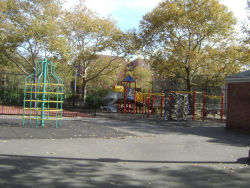Greenwood Playground
Greenwood Playground
Greenwood Cemetery was commissioned in 1838 as the first nonsectarian cemetery in the City of Brooklyn. Its striking Victorian gatehouses and shelters, contemplative winding paths, reflecting lakes, and a majestic view of New York harbor from its heights, drew thousands onto the grounds of the cemetery for walks or picnics. Greenwood’s immediate popularity, not only for burials, but as one of Brooklyn’s first large public spaces, demonstrated to city planners the importance of open, green spaces within the burgeoning metropolis. The cemetery remained the largest green space in Brooklyn until the opening of Prospect Park in 1866.
Today, Greenwood Cemetery, mostly unchanged, remains a dominant feature in the Windsor Terrace and Kensington neighborhoods. It covers 478 acres and contains 550,000 interments and monuments. It is the final resting place of jeweler Louis Comfort Tiffany (1848-1933), telegraph inventor Samuel F.B. Morse (1791-1872), and composer Leonard Bernstein (1918-1990), as well as the home of memorials to horses, volunteer firefighters, and merchant seamen.
Greenwood Playground first opened to the public on December 19, 1935, as one of hundreds of Works Progress Administration-era playgrounds commissioned throughout the city, and built under the direction of Parks Commissioner Robert Moses (1888-1981). It contained a recreational building, a large wading pool, and standard playground features such as seesaws, monkey bars, slides, handball courts, and an open play area. At the time, its single acre was surrounded by residential lots to the east and the Greenwood Avenue Methodist Church to the north. The Board of Transportation had leased land underground from the Board of Estimate to build the cut-and-covered tunnel of the Independent Subway’s Fort Hamilton Parkway station. The playground was built after completion of the subway station. Parks permanently acquired this land for $50,000 in 1941, and added it to the parkland.
Since the early 1950s, the playground has been greatly transformed. The recreation building was demolished (and replaced by the present public restroom), a spray shower replaced the wading pool, and basketball courts and a softball field were created on the site of a demolished filling station. A small plaza and sitting area at the northern edge of the triangular property leads to a pedestrian bridge spanning the expressway. The playground became the largest in a band of small parks that stretches the length of the Prospect Expressway.
The monument that stands at the northern edge of the park was dedicated on November 11, 1922, to 47 men from the neighborhood who died in the U.S. Army and Navy during World War I. Photographs reveal that it originally stood in a garden on the grounds of nearby P.S. 130, but was moved in 1944 to its present location because of the expansion of Fort Hamilton Parkway.
Commissioned by the Citizens Memorial Association of District 61 for $13,000 and sculpted by Charles Keck (1875-1951), a student of famed American sculptor Augustus Saint-Gaudens, the bronze relief set in polished granite depicts a weary Liberty placing a palm of Peace on the altar of Sacrifice. Littered around her are the detritus of war: bayonets, chains, a helmet, a rifle stock. The names of the war dead are inscribed into the altar, and their battles inscribed into the stone on either side.
Greenwood Playground is bounded by Fort Hamilton Parkway, and Prospect and Greenwood Avenues. Renovation needs for Greenwood Playground were identified in 1985, and construction and restoration were completed in 1993 for over $1 million. The designers, Signe Nielsen Landscape Architects, replaced the Works Progress Administration-era (WPA) playground features with new modular equipment, and restored sections of the basketball courts and softball fields. The monument plaza was also restored with new brick pavers, stone benches, and an enclosed planting area.
Check out your park's Vital Signs
Clean & Safe
Green & Resilient
Empowered & Engaged Users
Share your feedback or learn more about how this park is part of a
Vital Park System

